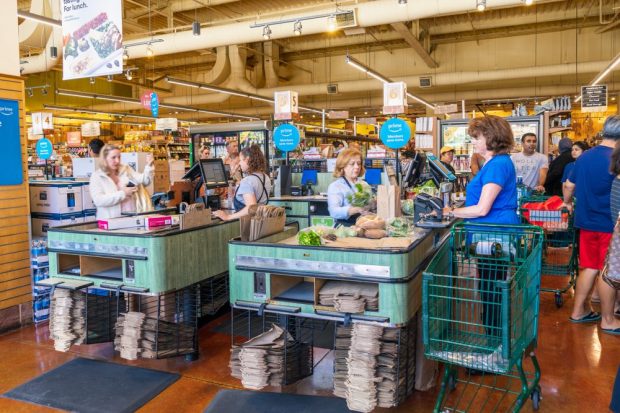Grocers See Even High-Income Consumers Reining in Spending

With consumers continuing to reel at food inflation, even upscale grocers are forced to adjust.
Whole Foods Market, for instance, Amazon’s premium grocery retailer, recently asked suppliers to lower their wholesale prices so that the chain could reduce prices for consumers, The Wall Street Journal reported Tuesday (Jan. 31), citing a virtual meeting.
“We know our customers are weighing the impacts of inflationary pressure on their buying choices,” Alyssa Vescio, Whole Foods’ senior vice president of merchandising, center store, reportedly said in the meeting.
Whole Foods declined to comment on the report to PYMNTS.
The news comes as inflation begins to ease, but consumers are not feeling the relief. In August, U.S. Bureau of Labor Statistics (BLS) data showed that grocery prices were up 13.5% year over year. In December, these increases relative to 2021 were up a moderately lower 11.8%.
Yet, shoppers are not feeling an improvement; rather, they predict ongoing challenges for some time. PYMNTS’ December study “Consumer Inflation Sentiment: In It For The Long Haul,” for which we surveyed more than 2,300 U.S. adults, finds that consumers on average, believe it will take another 20 months before inflation returns to 2021 levels.
Grocers see the same, as Barbara Connors, vice president of commercial insights at 84.51°, the marketing insights subsidiary of grocery giant Kroger, noted in an interview with PYMNTS. She predicted that throughout 2023, shoppers’ behaviors would continue to reflect ongoing price anxiety.
“We’ve been trending the same question of, ‘How concerned are you with inflation?’ for over a year, and it’s still sitting at two thirds of shoppers that are highly concerned,” Connors said.
Consequently, even higher-earning grocery shoppers are seeking more affordable options. Walmart, the world’s largest grocer, noted on its last earnings call in November, discussing its Q3 financial results it has been gaining higher-income food customers, suggesting that those big earners are trading down.
“We’ve continued to gain grocery market share from households across income demographics, with nearly three-quarters of the share gain coming from those exceeding $100,000 in annual income,” CFO John Rainey said.
Part of this shift may come from a change in financial lifestyles. Research from the latest edition of PYMNTS’ “New Reality Check: The Paycheck-To-Paycheck Report,” created in collaboration with LendingClub, which draws from a December survey of nearly 4,000 U.S. consumers as well as an analysis of other economic data, finds that growing shares of U.S. consumers at all income levels are now living paycheck to paycheck.
In fact, even the majority of high-income consumers are doing so. Fifty-one percent of consumers earning more than $100,000 annually said they lived paycheck to paycheck, up 9% from 42% in December 2021.
Indeed, nearly half of all consumers are abandoning their former go-to grocers for lower-priced alternatives. Research from the October edition of PYMNTS’ Consumer Inflation Sentiment study, “Consumer Inflation Sentiment: Consumers Buckle Down On Belt-Tightening,” which draws from a survey of more than 2,600 U.S. consumers in September, finds that 47% of consumers are switching to cheaper merchants.
